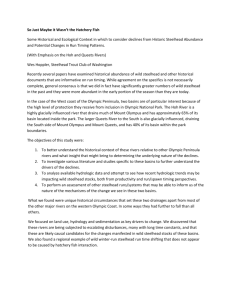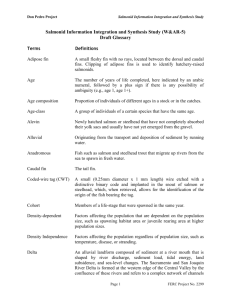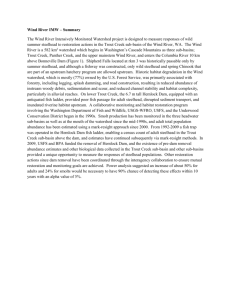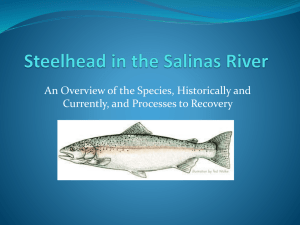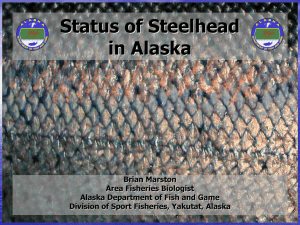Background - USDA Forest Service
advertisement
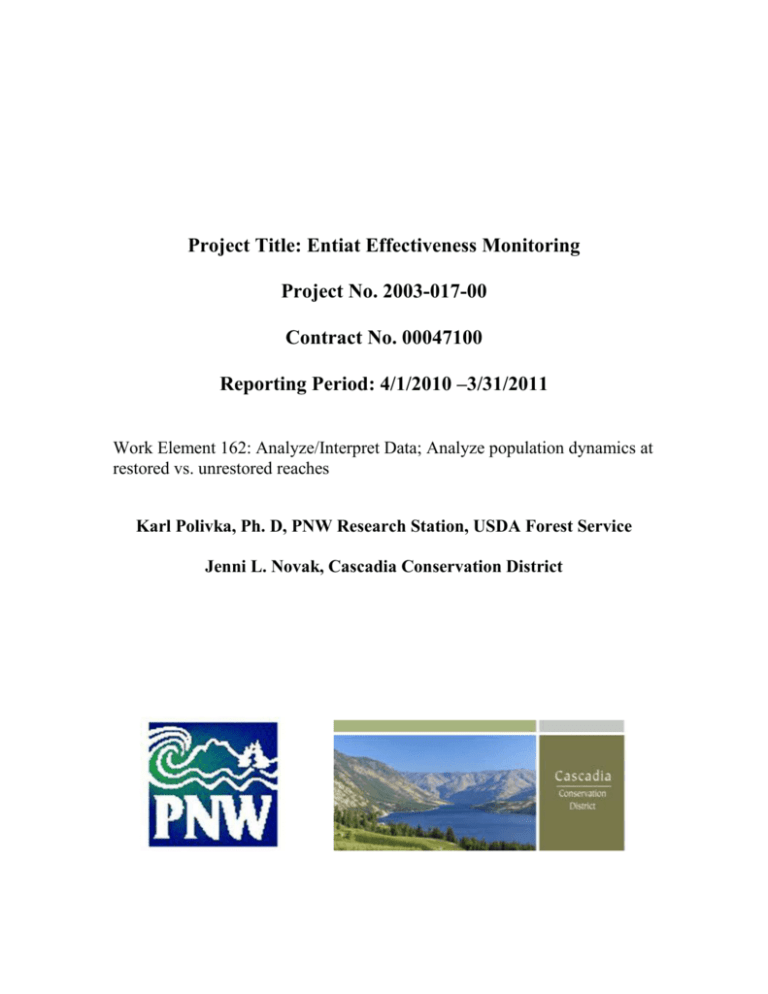
Project Title: Entiat Effectiveness Monitoring Project No. 2003-017-00 Contract No. 00047100 Reporting Period: 4/1/2010 –3/31/2011 Work Element 162: Analyze/Interpret Data; Analyze population dynamics at restored vs. unrestored reaches Karl Polivka, Ph. D, PNW Research Station, USDA Forest Service Jenni L. Novak, Cascadia Conservation District Background In 2010, we continued to assess restoration efforts and detect effects on populations of Chinook salmon (Oncorhynchus tschawytscha) and steelhead (O. mykiss) population size, individual growth and movement at the reach scale. Our work focused on the Lower Entiat River in a single reach treated with small engineered log jams (N = 4) and rock barbs (N = 6) designed by the Bureau of Reclamation to enhance salmonid rearing habitat. These structures formed pools that averaged 46 cm deep (range: 23 – 68 cm) and 41 m2 in area (range: 14 – 73 m2). A geomorphically similar control reach ~ 500 m upstream of the treated reach was used for comparison of the fish population response variables listed above. Three hypotheses remained under consideration: 1) we expected to observe higher density of fish in the treated reach compared to the control reach, 2) fish growth and movement would show habitat quality and density dependence, and 3) that restoration would be mediated by environmental variables. We compared density between 2009 and 2010. Previous observations included a substantial numerical response of Chinook salmon to the restoration treatments. Steelhead were more variable in density showing no only slight effects. Furthermore habitat affinity showed differences between treated/control reaches and between species. In 2010 we continued the study of movement to consider a different time scale and used the mark-recapture data to estimate differences in growth. Methods We conducted multiple censuses of fish density in pools created by the structures in the treated reach and in similar sized pools in the control reach. We used snorkeling and seining to capture fish from August 16 to October 22, 2010. High flow regimes and sediment load resulted in a later start in comparison to the 2009 sampling period, which began July 13th. Each captured Chinook and steelhead was marked with a subcutaneous injection of visual implant elastomer and size data (length and weight) was observed. Total fish, Chinook, and steelhead densities were calculated (relative to the area and depth of the habitat). Total growth of individual fish was calculated based on the recapture data obtained over the entire sampling period. We calculated growth rate by counting the number of days between the capture event in which a fish was first captured and when it was last captured. We used the difference in length, standardized by the total number of days between initial and final captures, as the measure of growth in mm/day. All growth data were combined for each species in each reach. Recaptures were expected to occur at different times, and some data were obtained from fish that occupied more than one pool during the study period; thus, we did not attempt to calculate average growth per pool. The effects of density dependence were assessed by analyzing growth and movement of each fish in correlation with the average density of fish at each pool. To examine the effect of fish density on growth, we compared total growth rates with total and species-specific densities. For each individual fish, we used the average density of total fish from the pool in which the fish was observed during each recapture census. We used a one-way analysis of covariance (ANCOVA) to identify differences in mean growth in the treated reach compared with the control reach. Mean density, initial standard length (SL), temperature (total degree days), and average flow rate per pool were used as covariates in the analyses presented here. In 2009, we observed that habitat affinity over a 24 hour period was greater in the treated reach compared with the control reach for both steelhead and Chinook. In 2010, we collected our data in a way that allowed us to keep track of individual recaptures through time during multiple recapture censuses. We used these observations to determine whether the habitat affinity patterns we observed over 24 hr in 2009 hold through longer time periods. Fish marked in pools at the control and treated reaches during the initial capture events (mid-August and early September) were recaptured during subsequent censuses. Individuals were given unique color markings so that they could be grouped by original capture date and pool. We calculated the fraction of fish initially captured at each recapture date (Table 1) and an average for each pool in the midAugust and early September mark groups. We analyzed the recapture rates for differences among categories of mark group timing (mid-August vs. early September), species (steelhead vs. Chinook), and reach (treated vs. control) using a three-way analysis of variance (ANOVA). To assess whether temporal variation in fish density was associated with environmental variables such as temperature, flow, dissolved oxygen, and depth, we analyzed mean density at microhabitats in each reach with two-way analysis of covariance (ANCOVA) where all measured environmental variables were used as covariates and time was entered as a random factor. From the multiple regression output in the covariate analysis, we examined the influence of environmental variables on steelhead and Chinook density. Treatment 8/16 – 8/19 Control 8/23 – 8/26 Week 1 Initial Captures Week 2 8/30 – 9/1 9/7 – 9/9 Initial Captures Week 3 9/13 – 9/16 9/20 – 9/23 Recaptures Week 4 9/27 – 9/30 10/21 – Recaptures 10/22 Week 5 10/18 – Recaptures 10/20 Table 1. Initial capture and recapture dates of fish in treated and control reaches during 2010 sampling period. Results and Discussion During both 2009 and 2010 sampling periods total fish density changes over time but not between the treatment reach compared with the control reach (Figs. 1a, 2a). Chinook and steelhead showed different patterns of density through the season. Chinook density was higher in the treated reach and decreased over time in both reaches (Figs. 1b, 2b); whereas steelhead density was more variable. Chinook density in 2010 was higher in the treated reach in the mid-August samples only and rapidly declined to be statistically indistinguishable from the control reach. Steelhead density was marginally higher in the control reach in 2009 and considerably higher in the control reach in 2010 (Figs. 1c, 2c). Time factors in repeated measures ANOVA were significant for Chinook and total fish density but not for steelhead. We recaptured a total of 49 individual Chinook in pools in the treated reach (14.1%), but only 7 in the control reach (25%). ANCOVA indicated that growth between reaches was not significantly different (F1, 51 = 0.455, p = 0.503; Fig. 3a), partially due to the extremely low recapture rate in the control reach. Initial size was a highly significant covariate (p = 0.0008) but density was not (p = 0.411), nor was any other covariate, suggesting that either the range of density observed during most of this study was not great enough to cause intra- and interspecific competition or that other aspects of chinook bioenergetics contribute more strongly to growth than intra- and interspecific competition. We recaptured 133 (61.9%) steelhead in the treated reach and 66 (62.9%) in the control reach. Steelhead grew 1.5 times more in the treated reach compared with the control reach (F1, 193 = 11.38, p = 0.0009; Fig. 3b). This effect was independent of density (p = 0.999), despite the observation that steelhead had higher density in the control reach through the study season. Initial size was a strong correlate of growth in steelhead (p = 0.003). There was a significant and slightly negative correlation with total degree days (beta=0.184, p=0.011). Few differences in recapture rates were identified; steelhead showed higher recapture frequency than Chinook (F1, 60 = 6.17, p = 0.016), but the date of initial capture and marking also strongly influenced recapture frequency (F1, 60 = 7.25, p = 0.009, Fig. 4). For steelhead, the lack of difference in recapture rates between the treated and control reach for either the midAugust or early September groups is consistent with our observation from 2009 that in the late season, steelhead are as likely to show affinity for pools in the treated reach as for those in the control reach. Low recapture rates for Chinook salmon, particularly in the mid-August group are likely due to late summer migration of individuals toward overwintering areas downstream. This would be consistent with our observation in both 2009 and 2010 that Chinook density declines rapidly in mid-tolate August. High variation in recapture rates among pools across this longer time scale likely confounded any effects of habitat/reach. Further study is required to determine whether longer-term habitat affinity patterns are affected by habitat treatments. ANCOVA showed no overall difference in density between reaches for either chinook or steelhead, but the strong influence of temporal differences described in Figs. 1 & 2 was apparent and time interacted significantly with reach. Covariate analysis showed that some environmental variables were associated with chinook and steelhead density (Table 2). Both species are more abundant at warmer temperatures. It appears that Chinook prefer deeper water. Flow was not a significant factor in Chinook density. Steelhead appeared to prefer shallower, faster water. Mean flow rates were faster in the control reach (not shown here), which may account for higher steelhead density at control sites. Our results indicate that species respond differently to the placement of in- stream habitat restoration structures. Steelhead growth showed that, despite lower total density at the restoration structures, individuals benefit in terms of fitness correlates in treated reaches. It is unknown whether the increased habitat affinity observed in 2009 is the result of enhanced foraging opportunities leading to increased growth. It remains poorly understood why steelhead density remains, nevertheless, higher in the untreated reach compared with the treated reach. It is further counterintuitive that steelhead density showed a positive correlation with temperature, but that growth showed an inverse relationship with total degree days. More investigation of steelhead bioenergetics and optimal temperature is warranted. Both total density and recapture rates for Chinook are so low in the untreated reach that it is difficult to interpret the observed lack of growth difference, longerterm habitat affinity or lack of density dependence in either response. Chinook R 2 = 0.235 F4, 79 = 6.07 p = 0.0003 FLOW TEMP DO DEPTH beta 0.157 0.345 -0.067 0.269 t 87 1.62 3.45 -0.67 2.69 p 0.110 0.0009 0.487 0.007 Steelhead R 2 = 0.164 F4, 79 = 3.86 p = 0.006 FLOW TEMP DO DEPTH beta 0.201 0.383 0.001 -0.228 t 79 1.88 3.49 0.007 -2.14 Table 2. Multiple regression analysis p 0.063 0.001 0.994 0.035 a) Effect Reach Time RXT F 1.21 53.93 2.17 df 18 36 36 p 0.286 <0.001 0.129 b) Effect Reach Time RXT F 25.63 66.45 12.74 df 18 36 36 p <0.001 <0.001 <0.001 c) Effect Reach Time RXT F 3.64 22.42 4.162 df 18 36 36 p 0.073 <0.001 0.024 Figure 1. 2009 mean density of total fish(a), Chinook(b) and steelhead(c) in reaches treated with restoration structures and in control (untreated) reaches July – September, 2009. Differences between treatment and control reaches and temporal effects were analyzed with repeated measures ANOVA. a) Effect Reach Time RXT F 0.009 9.10 6.01 df 17 51 51 p 0.924 < 0.001 0.001 b) Effect Reach Time RXT F 15.38 18.93 15.93 df 17 51 51 p 0.001 < 0.001 < 0.001 c) Effect Reach Time RXT F 11.10 1.56 1.52 df 17 51 51 p 0.004 0.208 0.222 Figure 2. 2010 mean density of total fish(a), Chinook(b) and steelhead(c) in reaches treated with restoration structures and in control (untreated) reaches August – October, 2010. Differences between treatment and control reaches and temporal effects were analyzed with repeated measures ANOVA. Figure 3a. Mean growth of Chinook in treated reach vs. control reach over the 2010 sampling period. Figure 3b. Mean growth of steelhead in treated reach vs. control reach over the 2010 sampling period. Figure 4. Recapture rates for Chinook and steelhead over the 2010 sampling period. Figure 4. Recapture rates for Chinook and steelhead over the 2010 sampling period.
